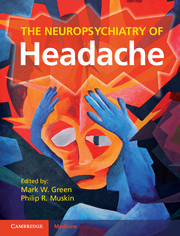15 results
18 - Complementary and alternative treatments for mood disorders
- from Section 2 - Medical management
-
-
- Book:
- Clinical Handbook for the Management of Mood Disorders
- Published online:
- 05 May 2013
- Print publication:
- 09 May 2013, pp 245-257
-
- Chapter
- Export citation
13 - Depression in the context of physical illness
- from Section 2 - Medical management
-
-
- Book:
- Clinical Handbook for the Management of Mood Disorders
- Published online:
- 05 May 2013
- Print publication:
- 09 May 2013, pp 181-194
-
- Chapter
- Export citation
List of contributors
-
-
- Book:
- Clinical Handbook for the Management of Mood Disorders
- Published online:
- 05 May 2013
- Print publication:
- 09 May 2013, pp vii-x
-
- Chapter
- Export citation
Index
-
- Book:
- The Neuropsychiatry of Headache
- Published online:
- 05 March 2013
- Print publication:
- 07 March 2013, pp 164-169
-
- Chapter
- Export citation
Contributors
-
-
- Book:
- The Neuropsychiatry of Headache
- Published online:
- 05 March 2013
- Print publication:
- 07 March 2013, pp vi-viii
-
- Chapter
- Export citation
The Neuropsychiatry of Headache - Half title page
-
- Book:
- The Neuropsychiatry of Headache
- Published online:
- 05 March 2013
- Print publication:
- 07 March 2013, pp i-ii
-
- Chapter
- Export citation
Preface
-
-
- Book:
- The Neuropsychiatry of Headache
- Published online:
- 05 March 2013
- Print publication:
- 07 March 2013, pp ix-x
-
- Chapter
- Export citation
Copyright page
-
- Book:
- The Neuropsychiatry of Headache
- Published online:
- 05 March 2013
- Print publication:
- 07 March 2013, pp iv-iv
-
- Chapter
- Export citation
Chapter 13 - Somatoform disorders and headache
-
-
- Book:
- The Neuropsychiatry of Headache
- Published online:
- 05 March 2013
- Print publication:
- 07 March 2013, pp 149-163
-
- Chapter
- Export citation
Contents
-
- Book:
- The Neuropsychiatry of Headache
- Published online:
- 05 March 2013
- Print publication:
- 07 March 2013, pp v-v
-
- Chapter
- Export citation
The Neuropsychiatry of Headache - Title page
-
-
- Book:
- The Neuropsychiatry of Headache
- Published online:
- 05 March 2013
- Print publication:
- 07 March 2013, pp iii-iii
-
- Chapter
- Export citation
Chapter 4 - Mood disorder and headache
-
-
- Book:
- The Neuropsychiatry of Headache
- Published online:
- 05 March 2013
- Print publication:
- 07 March 2013, pp 30-41
-
- Chapter
- Export citation

The Neuropsychiatry of Headache
-
- Published online:
- 05 March 2013
- Print publication:
- 07 March 2013
29 - Complementary and alternative medicine approaches to the treatment of anxiety
- from Section 4 - Treatment of anxiety: current status and controversial issues
-
-
- Book:
- Anxiety Disorders
- Published online:
- 10 November 2010
- Print publication:
- 26 August 2010, pp 336-347
-
- Chapter
- Export citation
Contributors
-
-
- Book:
- Anxiety Disorders
- Published online:
- 10 November 2010
- Print publication:
- 26 August 2010, pp vii-xii
-
- Chapter
- Export citation



